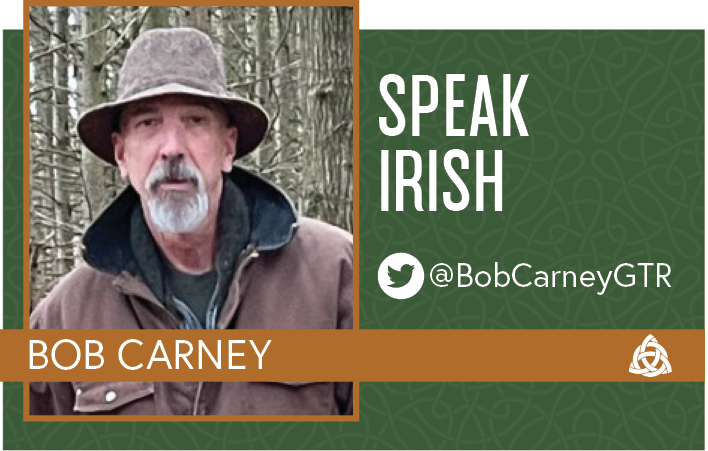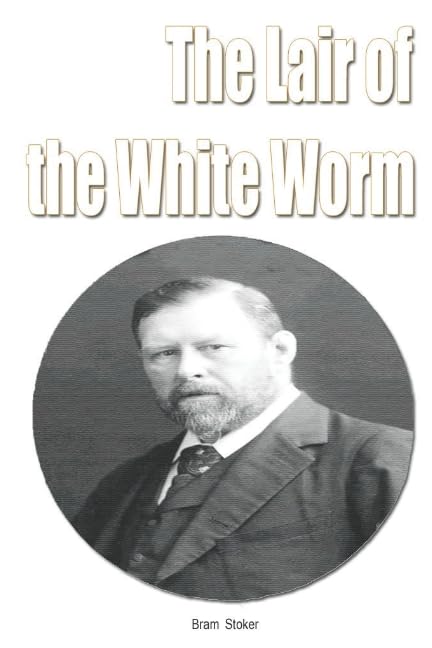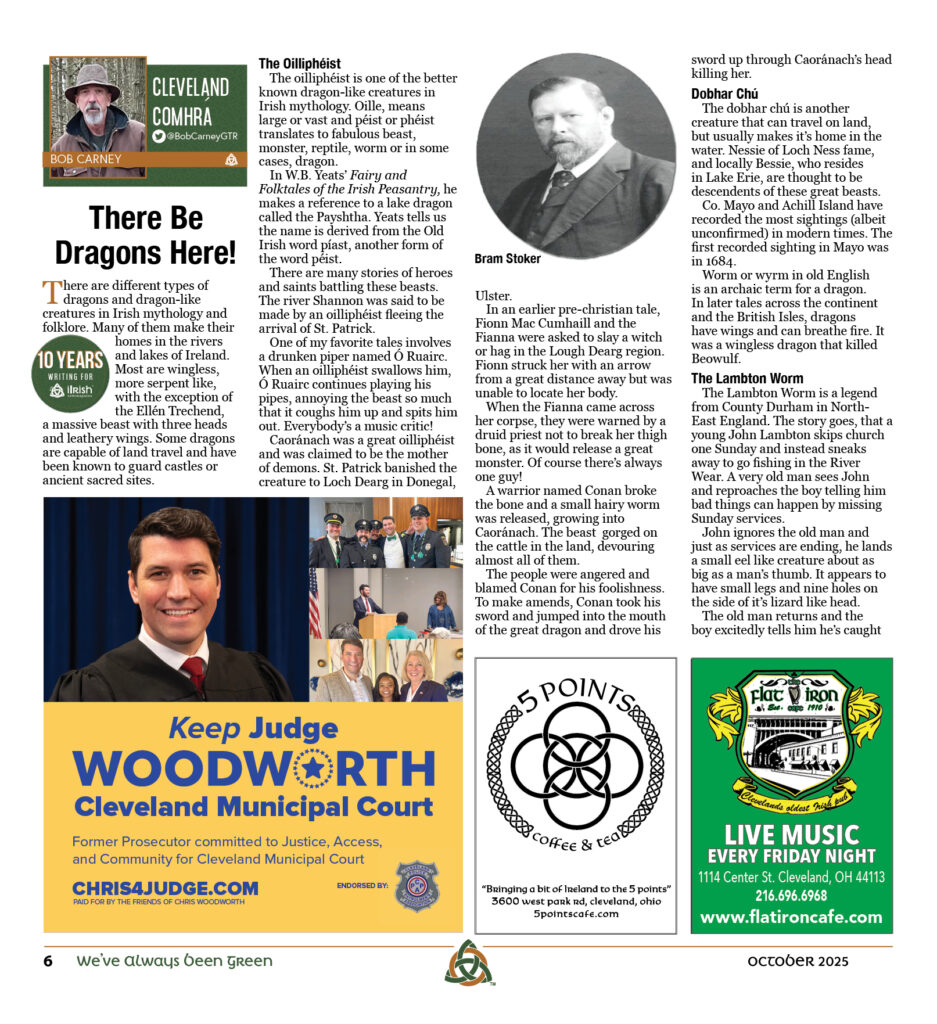
There Be Dragons Here!
There are different types of dragons and dragon-like creatures in Irish mythology and folklore. Many of them make their homes in the rivers and lakes of Ireland. Most are wingless, more serpent like, with the exception of the Ellén Trechend, a massive beast with three heads and leathery wings. Some dragons are capable of land travel and have been known to guard castles or ancient sacred sites.
The Oilliphéist
The oilliphéist is one of the better known dragon-like creatures in Irish mythology. Oille, means large or vast and péist or phéist translates to fabulous beast, monster, reptile, worm or in some cases, dragon.
In W.B. Yeats’ Fairy and Folktales of the Irish Peasantry, he makes a reference to a lake dragon called the Payshtha. Yeats tells us the name is derived from the Old Irish word píast, another form of the word péist.
There are many stories of heroes and saints battling these beasts. The river Shannon was said to be made by an oilliphéist fleeing the arrival of St. Patrick.
One of my favorite tales involves a drunken piper named Ó Ruairc. When an oilliphéist swallows him, Ó Ruairc continues playing his pipes, annoying the beast so much that it coughs him up and spits him out. Everybody’s a music critic!
Caoránach was a great oilliphéist and was claimed to be the mother of demons. St. Patrick banished the creature to Loch Dearg in Donegal, Ulster.
In an earlier pre-christian tale, Fionn Mac Cumhaill and the Fianna were asked to slay a witch or hag in the Lough Dearg region. Fionn struck her with an arrow from a great distance away but was unable to locate her body.
When the Fianna came across her corpse, they were warned by a druid priest not to break her thigh bone, as it would release a great monster. Of course there’s always one guy!
A warrior named Conan broke the bone and a small hairy worm was released, growing into Caoránach. The beast gorged on the cattle in the land, devouring almost all of them.
The people were angered and blamed Conan for his foolishness. To make amends, Conan took his sword and jumped into the mouth of the great dragon and drove his sword up through Caoránach’s head killing her.
Dobhar Chú
The dobhar chú is another creature that can travel on land, but usually makes it’s home in the water. Nessie of Loch Ness fame, and locally Bessie, who resides in Lake Erie, are thought to be descendents of these great beasts.
Co. Mayo and Achill Island have recorded the most sightings (albeit unconfirmed) in modern times. The first recorded sighting in Mayo was in 1684.
Worm or wyrm in old English is an archaic term for a dragon. In later tales across the continent and the British Isles, dragons have wings and can breathe fire. It was a wingless dragon that killed Beowulf.
The Lambton Worm
The Lambton Worm is a legend from County Durham in North-East England. The story goes, that a young John Lambton skips church one Sunday and instead sneaks away to go fishing in the River Wear. A very old man sees John and reproaches the boy telling him bad things can happen by missing Sunday services.
John ignores the old man and just as services are ending, he lands a small eel like creature about as big as a man’s thumb. It appears to have small legs and nine holes on the side of it’s lizard like head.
The old man returns and the boy excitedly tells him he’s caught the devil himself. The man warns him of the danger of this monster and John decides to dispose of his catch by throwing it down a well.
Years pass and John, now a grown man, joins the Crusades. While he is away, the forgotten creature grows and grows. The well has become poisonous, and livestock begin to go missing. Before long the beast is too large to return to the well and wraps itself around a hill.
The wyrm terrorizes nearby villages, eating cattle, sheep and even children. Brave men that try to kill the beast are killed and eaten. Visiting knights also try, but none survive. When wounded, the wyrm instantly heals itself and seems to be invincible.
The beast makes it’s way to Lambton Castle, where John’s very old father manages to sedate the creature by filling a trough with fresh milk every morning. Seven years later John returns home and finds his father’s estate in financial ruin and hears about the devastation caused by the monster.
John is determined to kill the beast, but decides to seek the guidance of a witch to fight this demon. The witch recounts the story of the boy fishing and tells John he is responsible for this creature’s existence.
The witch tells him to cover his armor with spearheads and to fight the beast in the River Wear, where he sleeps coiled around a massive rock. After he kills it, she tells him to kill the next living thing he sees or his family will be cursed for nine generations.
John devises a plan and tells his father, when he kills the creature he will sound his hunting horn three times. His father is to release John’s favorite hound, who will run to him. John will kill the dog and avoid the curse.
The battle is hard but John hacks away at the wyrm and the current whisks the parts away before they can rejoin the creature. John strikes a fatal blow and the wyrm is destroyed.
He quickly sounds his horn, but his father in his excitement forgets to release the hound and runs to his son. John cannot bear to kill his father, so he waits and kills the hound on his return to the castle.
But it’s too late, nine generations of Lambtons are cursed and will not die peacefull deaths. One is known to have drowned, at least two perished in battle and the ninth generation, Henry Lambton died in his carriage crossing Lambton Bridge in 1761.
The Lair of the White Worm
The final work of Dublin native Bram Stoker was written at the end of his life. Stoker was sickly and heavily medicated, but his publisher pushed him for one final book.
Some claim madness had descended on Stoker because of the illness or perhaps the cure. In spite of that, he wrote The Lair of the White Worm. Not nearly as well known as Dracula, but a very good gothic horror story. It involves ancient beliefs and stories, our hero, a beautiful woman with a dark side and of course, a dragon.

Many believe Bram’s inspiration came from the legend of the Lambton Worm. I’m not so sure. Stoker was sickly as a child and was cared for by the family nanny. Ellen Crone may have shared many of Ireland’s legends and myths with young Bram, who could have drawn upon them later in life in his writing.
I hope this Halloween season you explore the rich stories from Ireland. You’ll find vampires, headless horsemen, werewolves, witches, ghosts and even dragons.





